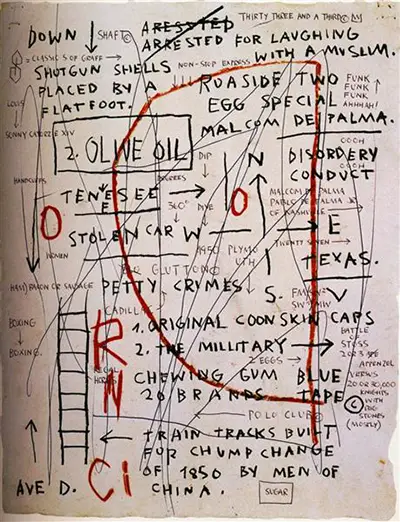It is often hard at first to understand the scrawled words of this artist's work. Once we have a broader understanding of his career, though, we then start to piece together these different jigsaw pieces which together create the overall composition. There is a huge red line that sweeps around in a seemingly random position, with further letters in red dotted around the left hand corner of the painting. We then find Olive Oil written in capitals and surrounded by a black border which immediately points our eyes towards it. Several sentences refer to methods of arrest, and there is then a reference at the bottom to the formation of train tracks by Chinese immigrants, which is something he mentioned in a number of these word-heavy designs from the early 1980s.
Basquiat was an exciting fusion of cultures which would play out directly on canvas. When combined with the emotions of a man who came from a troubled background, it was an unfortunate recipe, but also the type of conditions where many a talented artist might rise. He would combine emotion and technical prowess together and over time develop his own unique approach to the particular issues that he chose to focus on. He would help to change the art world, undoubtably, and bring new opportunities in future generations to some who might otherwise have been overlooked were it not for the impact made by his work. It was an important stepping stone towards ultimately achieving a fairer world, as he saw it, in which we can all be judged equally and on the merits of our work. This evolution continues today and these topics are in our minds as much as they ever have been.
One can appreciate the depth of emotion found in the expressive nature of titles such as Boxer Rebellion, La Hara and Per Capita. Basquiat has much to say about the world, and would use his own platform to spread the word of communities who were rarely given a voice within the art industry. Things have changed somewhat in recent years, but during the period of Basquiat's life, things were still dominated from an established set of backgrounds that could dictate which art would be promoted. He would help to change that and also to encourage the public to look into alternative opinions on society, perhaps even changing their own perceptions of it. This continues to evolve in today's art world, and things are starting to become a little more equal in terms of representation from female artists and also those from minority communities, which at the very least helps to enrich the oeuvres that we come across on a daily basis.


